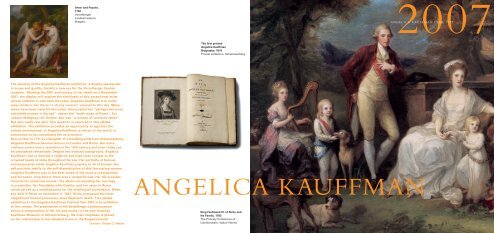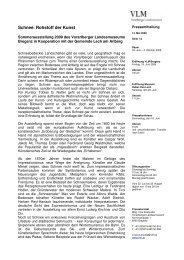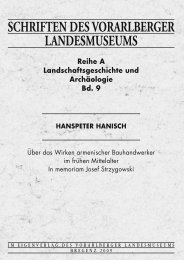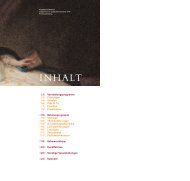ANGELICA KAUFFMAN
ANGELICA KAUFFMAN
ANGELICA KAUFFMAN
You also want an ePaper? Increase the reach of your titles
YUMPU automatically turns print PDFs into web optimized ePapers that Google loves.
Amor and Psyche,<br />
1792<br />
Vorarlberger<br />
Landesmuseum,<br />
Bregenz<br />
The opening of the Angelica Kauffman exhibition, a display spectacular<br />
in scope and quality, heralds a new era for the Vorarlberger Landesmuseum.<br />
Marking the 200 th anniversary of her death on 5 November<br />
2007, the display will explore the timeliness of this exceptional artist,<br />
whose radiance is unbroken till today. Angelica Kauffman is in many<br />
ways modern, her life as “a strong woman” unusual to this day. Many<br />
terms have been used for this artist. Some called her “perhaps the most<br />
cultivated woman in Europe”, others the “tenth muse of Rome”. For<br />
Johann Wolfgang von Goethe, she was “a woman of immense talent”.<br />
But who really was she? This question is explored in this jubilee<br />
exhibition. The exhibition provides an opportunity to appraise the<br />
artistic development of Angelica Kauffman, a citizen of the world, in<br />
connection to her remarkable life as a woman.<br />
Born in Chur in 1741 as a daughter of a travelling artist from Schwarzenberg,<br />
Angelica Kauffman became famous in London and Rome. Her extraordinary<br />
career was a sensation in the 18th century and even today can<br />
be considered remarkable. Despite her ordinary background, Angelica<br />
Kauffman rose to become a celebrity and kept close contact to the<br />
crowned heads of state throughout Europe. Her portraits of famous<br />
contemporaries made Angelica Kauffman popular in all of Europe. Her<br />
self-portraits testify to the self-dramatization of this fascinating woman.<br />
Angelica Kauffman was in the best sense of the word a cosmopolitan<br />
and European, long before there was a united Europe. Her life provides<br />
material for numerous novels: the affairs surrounding her marriage<br />
to a swindler, her friendship with Goethe, and her salon in Rome<br />
which served as a meeting point for the intellectual prominence. When<br />
she died in Rome on November 5, 1807, Rome witnessed the most<br />
magnificent funeral procession since Raphael’s death. This jubilee<br />
exhibition in the Angelica Kauffman Festival Year 2007 is an exhibition<br />
at two venues: The presentation in the Vorarlberger Landesmuseum<br />
shows a compendium of her life and works; in the new Angelica<br />
Kauffman Museum in Schwarzenberg, the main emphasis is placed<br />
on her relationship to her adopted home in the Bregenzerwald.<br />
Curator: Tobias G. Natter<br />
The first printed<br />
Angelica Kauffman<br />
Biography, 1810<br />
Private collection, Schwarzenberg<br />
Angelika Kauffmann machte als Frau in ihrer Zeit eine außergewöhnliche<br />
Karriere. Die Künstlerin mit Wurzeln im Bregenzerwald begeisterte schon<br />
die Zeitgenossen durch ihr Werk und faszinierte mit ihrer Lebensgeschichte.<br />
Das Vorarlberger Landesmuseum in Bregenz baute im Laufe<br />
seiner 150-jährigen Geschichte die umfangreichste Angelika-Kauffmann-<br />
Sammlung weltweit auf.<br />
<strong>ANGELICA</strong> <strong>KAUFFMAN</strong><br />
King Ferdinand IV. of Sicily and<br />
his Family, 1783<br />
The Princely Collections of<br />
Liechtenstein, Vaduz-Vienna<br />
2007<br />
A N G E L I C A K AU F F M A N Y E A R 2 0 0 7









